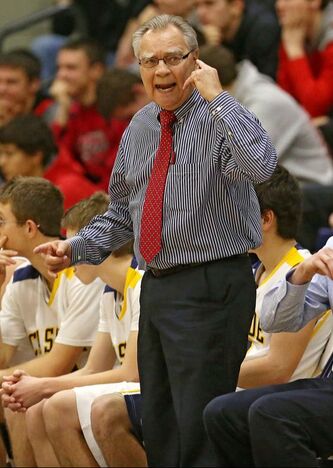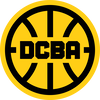
When I play Rec League basketball or pick-up at a random location these days, it usually goes one of two ways. The first, every player is a black hole, meaning once the ball is in their hands, there is no getting it back. Or second, nobody knows what a good shot is. Zero pass pull-up shot, after zero pass pull-up, not surprisingly, results in a total abomination of a game that stimulates ulcers in my stomach.
Contrary to informal games in other locales , whenever I walk into a gym in Cascade during the holidays for pick-up games, or a casual game at the local gym, I know I can expect a competitive, real basketball game--with ball movement, off-ball screens, communication, tough defense and good shots. All the players here seem to know how to play the game the right way. Playing basketball the right way requires a fundamental understanding of the game. In Cascade, this fundamental understanding comes from years of discipline and instruction taught by long-time head coach, Al Marshall, who coached Cascade High School teams to win over 700 games--the third highest in Iowa history. Coach Marshall narrows this understanding down to one word: toughness. When I sat down with Iowa Basketball Hall of Fame Coach Al Marshall, I didn’t really know what to expect. The only thing I was certain of was the subject we were going to discuss--toughness, one word that captures his whole philosophy, a word that was drilled into every practice with me and my teammates. Coach Marshall dissected the word toughness as if it were a high school cadaver science lesson; one action sparking the process of another like the way the muscles in our bodies work, but in a basketball sense. Imagine basketball concepts being broken down by an expert like a doctor explaining the practice of medicine to a novice. After talking hoops for a while and finally sitting down to conduct my interview, I saw Al had prepared five full pages of notes just on the subject of toughness. Looking back on my playing days under Coach Marshall and remembering how well-prepared he always was, I should have expected nothing less. Al’s coaching philosophy is simple: “build a team that centers its focus on fundamentals.” It wasn’t dumb luck that Al’s teams averaged 8.5 turnovers/game on the defensive end and limited opponents to 36%-40% shooting from the field. It wasn’t surprising to see Al’s best teams shoot 50%+ on the offensive end. “Practice does not make perfect,” according to Al, “practice makes permanent.” Create the right habits, focus on fundamentals, instill discipline in your game and you have a recipe for tough, successful players. Before talking about toughness and establishing a clear definition for players and coaches, Al thought it was appropriate to emphasize what toughness is not. Playing Through Injury "People sometimes talk about and praise a player for playing with an injury-- this is not toughness, it is stupidity,” according to Coach Marshall. “If you’re playing with an injury, you’re naturally less effective. You must be tough minded enough to know when you can and cannot play. There is a difference between playing through soreness and playing through injury. If you’re sore, yes, you need to toughen up and fight through that temporary pain. But if you’re hurt, you need to allow yourself time to recover to be game ready.” I dealt with this reality in high school when I didn't communicate a toe injury I was going through. It had impaired my game for a month and I told no one about it. I didn't want to appear soft or let my team down, so I thought I would fight through it. Ultimately, I was letting my team down because I wasn't able to give 100%. I ended up sitting out a few practices coming up to the postseason which set me back at the most important time of the year. The same thing happened in college, but this time I immediately had the wisdom to rest for a week and come back ready to work. Looking for the Limelight. Toughness is not looking to be the star or the center of media attention. Rather it is quite the opposite. Tough players stay humble and work with their heads down. Missing Free Throws Down The Stretch “When the pressure is on, true toughness comes out and I have never seen this exemplified more so than in shooting free throws down the stretch.” Being a Selfish Teammate "Tough players and tough teams know what it means to be tough together." Worrying About What You Look Like on The Court Success doesn't come because of the way you look on the court or by the brand of your sneakers. Likewise for coaches, your chances of winning aren’t enhanced by the coordination of your staff's apparel. What is toughness?
"In order to have toughness--to be mentally tough--I believe a player has to be disciplined" says Coach Marshall. “Some kids think discipline is detention, getting grounded, or any kind of punishment.” I asked Coach what his definition of discipline is. His response is worth memorizing: "What I believe discipline means, and what my players heard often, is that discipline is doing what you are supposed to do, when you are supposed to do it, to the best of your ability, EVERY TIME."
Coach emphasized the importance of discipline during practice: Do what you are supposed to do. Practice game-like drills at high intensity. Never give an effort that is less than 100%. When you are supposed to do it. Repetition = consistency. Getting the right amount of reps in every day. To the best of your ability. Go hard and hold yourself and your teammates to high standards. Practice at game-like speed. Every time. You create habits by repeating the same process over and over. Are you tough enough to practice the same things repeatedly until perfection? Ultimately this translates into you being prepared for any game situation. Contrarily, if you aren’t disciplined and have sloppy practice habits, those too, will translate and you will be unprepared to play in-game. The final four-minute-of-the-game test is where toughness is revealed. You must be disciplined. Fundamentals “Fundamentals are the building blocks of the house. It’s like the foundation of your house. Toughness is the finished product. You can’t have the finished product (toughness) without the foundation, without the fundamentals.” Take, for example the last four minutes of a close game. This is where toughness is exemplified and where practice shows. “If you have good habits, they will emerge. If you have bad habits, those will emerge.” The team with good habits will, more times than not, win; and the team with bad habits will think they are plagued by late-game misfortune. The team with good habits knows their win came from discipline and attention to detail on fundamentals; they were gritty, they were tough down the stretch when it mattered most. Fundamentals to focus and build on according to Al:
When the pressure is on, these habits will come to fruition, i.e. they will contribute to the outcome of the game:
Team Toughness Take individual toughness and multiply it by five and you have team toughness. “It is great when you have one tough player on the team,” says Al, but "having two is better. Having three is great. And when you have all five players on the court at the same time who are tough--that is when you find the greatest success as a team.” When you have a team of mentally tough players you will get PLAYERS WHO:
Coach printed these traits off and gave them to his players. I find them invaluable. At any level, these can be extremely useful for both coaches and players. They do not just appear. It takes months and even years to instill discipline in your team! Be patient, if you focus on fundamentals, you’ll find these things coming naturally. The Anatomy of a Successful Team Shot A successful shot involves a team of five mentally tough players. Teams that understand and practice TEAM SHOTS, tend to shoot in the upper 40 to low 50 percentiles. Look at the Miami Heat under Erik Spoelstra, Kentucky under John Calipari, Michigan State under Tom Izzo, and Duke under Coach K. Very similar shooting percentages, very similar success. There is a reason, they practice and preach discipline. Basketball is an up-tempo game, and to win that up-tempo game requires balls to go through the hoop. So, in order for you to score and have successful team shots at a rate greater than that of your opponent, it is important to do the following EVERY TIME down the floor. It starts with the individual.... Does the player set up their defender and cut hard to the ball? Does the screener set a solid screen, every time? Does the person targeted for the shot come off hard, shoulder to shoulder off the screener, every time? Does the passer deliver the ball on time and on target? Does the shooter, meeting all criteria for a GOOD shot, catch it ready to score? The anatomy of a successful team shot stems from each player's consciousness that it takes all five players on the court working in motion to reach the above outcome, each possession down the floor. Teams shooting in the 50%-range understand this, and know it takes a team effort to shoot at a high clip. "For teams, tough teams that is, the players that set screens and make passes accept their roles on the team." Al also says these players are acknowledged by both coaches and players when they fulfill their roles. I looked through some of Al’s seasons where his teams shot 50%+ from the field and found a predictable stat. In each of those years, the players that shot 50%+ from the field were taking the majority of the shots. The best shooters were shooting the ball the most. It is simple. Set your team up with a foundation for what a good shot is, and let your best shooters shoot the ball. The Right Acknowledgement "Tough teams are tough together." He would often stop practice and exclaim to a screener or a passer how they had done their job perfectly after setting a good screen or making a selfless pass, which would inspire confidence in those who were undertaking these roles on the team. Anyone who played for Al knows that he didn't just say things to make you feel good, he would only do this when you had performed to the team’s standards--which always felt good and would increase the likelihood of the player performing that role again. Knowing your Role To make this same process happen 60-70 possessions per game it is all about players accepting their roles and holding teammates accountable. Like I mentioned above, there are a lot of moving parts and a lot of dirt work that goes on behind the scenes (hard screen, exploding off screens, posting up hard). Naturally, every person wants to be the focal point the fans and media see--the shooter. As that may be desired on many teams, not everyone on tough teams wants to be the number one scorer or is tough enough to handle it. According to Coach, and witnessed by many at his practices, the best players and shooters are held to the same standards mentioned above in the criteria of a good shot. Al was on his best players from the moment they had laced up their shoes for practice until the final whistle had blown. It wasn’t that he had anything against this player, or was jealous of his basketball gifts, rather he was setting that player up to handle difficult situations and set a standard for the rest of the team. If ‘so and so best player’ was getting reamed for not coming off hard on a screen one time, other players want to step up their game to support their teammates and hold themselves to the same standards. Players wanting to be great: Are you tough enough to handle hard coaching? Can you respond to constructive criticism? You must be willing to take on the role as a leader and lead by example. Role players wanting success: Are you tough enough to accept your position and sacrifice for the greater good of the team to win basketball games? Are you conscious enough not to step out of your role, especially in the final four minutes of a close game? Are you tough enough to support every other member of the team and their roles? Coaching Example - Bad Shots An effective strategy Coach used to help players understand good vs. bad shots: Before the ball goes in the hoop on a bad shot, Al would say, loud enough for everyone to hear, “bad shot.” Now, even if the ball goes in, the player knows it wasn’t the best shot the team could’ve gotten in that particular possession. It is good to stop bad shooting habits in their tracks so you can instead focus on what a good shot is and how to achieve it every trip down the floor. Shooting a 20% shot and not addressing it is taking away the possibility of more 50% shots you could be getting. There are limited possessions in each game, so why waste them on bad shots? “When a player comes down the court and makes a bad shot (zero pass pull up jumper, one pass fadeaway jumper, etc.), I would stop him and say, ‘do you think that was a good shot?’ Of course the player would always say, ‘why yes I do, did you see that swish?’ I would propose a wager to this player - “If we did that same play and you took that same shot 100 times, for every time you make it, I'll give you one dollar. For every time you miss, you give me one dollar.” Al says the realization of that player's 15% shot would be a net loss of $75 to the coaches pocket. Of course this was not a real bet, but the wager would give the player perspective on the bad shot, and he would understand that just because he made it, it wasn’t a good shot. The Anatomy of Tough Defense Defense is controlled by a few things, attitude, effort and preparation. Attitude - Are you in the right mindset on defense? You need to want to play defense and you need to be mentally tough to be good on defense. Effort - Are you tough enough to play hard defense all game long? This comes to discipline in practice. Are you able to sit in a stance? Can you get a big stop down the stretch? Preparation - Are you able to carry out the scouting report? These are questions Al asks. If you’re wondering why, as a good offensive player, you don’t play and you answered ‘no’ to any of these questions, you have your answer. You must be able to defend. It is essential. Carrying out the scouting report is the most important discipline on the defensive end. Coach goes on, “We know the other team has a great three-point shooter that is not as effective off the dribble. We know this! If we are in a zone defense, is everyone clued in enough to know the shooter is in your area and you're there on the catch so he can't shoot? And again, EVERY TIME!! Are we, as a team, tough enough to force that player to score off the dribble?” It is vital, for the sake of winning, to be clued in on the scouting report at all times, and know where the best player on the other team is on the court. “I think the final step in a team being together is when all the players buy in, to the extent they hold themselves accountable, because they don’t want to let their teammates down.” A few things Al saw in all of his toughest teams were, “1) We won the vast majority of close games, especially tournament games. 2) Several times we won a conference championship where we would split with a team during the regular season and we would win all of our other games. The other team would lose to somebody they should not have lost to, handing us the championship. In the case of close games, we were used to our discipline (doing what you are supposed to do, when you are supposed to do it, to the best of your ability, EVERY TIME) so we were able to close out the late stages of games. In the case of beating a team we should have beat, we played possession by possession basketball and respected our opponents by playing hard.” I often wonder if people really understand what toughness on the basketball court really means. Taunting a player after a blocked shot, or pointing at yourself after a made basket are deceiving perceptions of toughness that we often see after ordinary plays. I see players in today's game, at all levels, trying to prioritize their image or worrying about what they look like in the eyes of the crowd or on TV. Seeing players concerned about how they look for their pre-game Instagram or Snapchat picture is the tell tale sign of weakness. Your focus on the task at hand, the game, is long gone the minute you start to worry about what you look like on your fans' social media feed. I hope that we are not confusing toughness with what someone looks like online. I was lucky to have been taught many valuable lessons on how to exhibit toughness on the court by Coach Marshall. I still utilize many of the lessons to this day, like seeking the toughest road, because I know the road less traveled, although difficult, leads to the best results, the most growth and the highest satisfaction. I, along with many people from my small hometown can be thankful we were taught the game the right way, the tough way.
By haris takes |
Archives
December 2023
Categories |
Proudly powered by Weebly

 RSS Feed
RSS Feed
